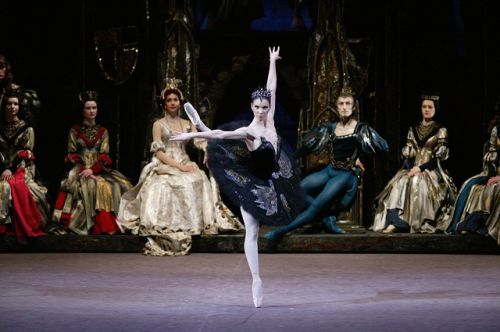 India Tchaikovsky, Swan Lake: Pathé Live ballet-screening, Godrej Dance Academy Theatre, National Centre for the Performing Arts (NCPA), Mumbai, 14.4.2013 (JSM)
India Tchaikovsky, Swan Lake: Pathé Live ballet-screening, Godrej Dance Academy Theatre, National Centre for the Performing Arts (NCPA), Mumbai, 14.4.2013 (JSM)
Cast:
Odette/Odile: Maria Alexandrova
Prince Siegfried: Ruslan Skvortsov
Rothbart: Nikolay Tsiskaridze
Jester: Vyacheslav Lopatin
Soloists and corps de ballet of the Bolshoi Theatre, Moscow
Orchestra of the Bolshoi Theatre
Production:
Musical Director: Pavel Sorokin
Libretto and Choreography:Yuri Grigorovich (after a scenario by Vladimir Begichev and Vasily Geltser)
With scenes choreographed by Marius Petipa, Lev Ivanov, Alexander Gorsky
Sets: Simon Virsaladze
Lighting: Mikhail Skolov

Phot Credit:Damir Yusupov
There are certain works of art that become synonymous with the genre they belong to. And surely, when one thinks of ballet, “Swan Lake” springs to mind.
Though created in the late 19th century, it has an evergreen, endlessly renewable quality that allows it to be interpreted afresh, keeping abreast with evolution in artistic sensibilities. Part of its appeal lies in its fairy-tale story…deceptively simple but loaded with deep shades of meaning and symbolism. And it is set to music of great passion and lyricism, by Tchaikovsky.
Probably the most famous modern interpretation of the ballet is in the film “Black Swan” which presents the Odette/Odile dichotomy as both alter-ego and doppelgänger. There is even a hugely successful gay version by Matthew Bourne. More conventional alterations made to the story include Rudolf Nureyev’s Vienna production which ended the ballet in stark tragedy, with the Prince and Odette drowning in the flooded lake, though in the original epilogue they are seen blissfully united in death. The Soviet authorities decided to give it an outright happy ending, with Odette saving the Prince from Rothbart; and the couple living happily ever after.
The choreographer Yuri Grigorovich was the architect of a legendary production at Moscow’s Bolshoi Theatre in 1969, which used such an ending. But the performance being screened by Pathé Live, also from the Bolshoi and choreographed by Grigorovich (and others) is of a different scenario, in which the entire swan saga is presented as a dream, or a figment of Prince Siegfried’s imagination. This robs the plot of impact; and comes across as a half-baked cerebral exercise, inconsistent and somewhat pretentious.
Moreover, the music has been chopped and changed, most damagingly at the conclusion. The ballet’s climax is originally set to some of the most gloriously thrilling music ever written, ending with the ‘swan’ theme resounding in a triumphant peroration of brass, percussion and full orchestra. Here, the music reverts to the Prelude and ends with a muted reiteration of the theme, ending in a whisper, leaving the Prince alone onstage and the audience bewildered as to what just happened.
The production is staged in four scenes and divided into two halves. Simon Virsaladze’s sets for the palace are elegantly devised, with diaphanous hangings against a cyclorama of streaked sky. By contrast, the lake is drab, bare and monochromatic in a dull blue-gray, a far cry from the atmospheric mise-en-scènes one has seen.
The dancing in this production is exquisite…and bloodless. Maria Alexandrova dances Odette with a pure classicism that is utterly beautiful to behold; but where is the characterisation, the swan queen’s vulnerability, her fluttery nervousness and fear giving way to love? Alexandrova’s Odile has some sparkle but little sense of dangerous sexuality (made unforgettable by the great dancer Maya Plisetskaya) and is ultimately not enough of a contrast. And she almost misses one of her 32 fouettés near the climax of her ‘black swan’ scene with the Prince.
Among the other principals, Ruslan Skvortsov’s athleticism and long leaps as Prince Siegfried are impressive; but Nikolay Tsiskaridze is an unmemorable cipher as Rothbart. However, the young dancer Vyacheslav Lopatin makes an agile, perky Jester. The corps de ballet dances with charm and precision, the four Cygnets are a perfectly co-ordinated delight; but the Spanish and Hungarian Dances lack fire and pizzazz.
The presentation at NCPA’s Godrej Theatre no longer had the severe audio anomalies experienced at the earlier Met Opera screening of “Otello” reviewed here . In fact, the quality of sound was sweet and clear; but it lacked power, being played-back at an inordinately soft level. The audience was heard complaining bitterly during the interval, after which there was some improvement…but not enough. This reviewer was told the recording was to blame; and indeed there may be some truth in that, since some of the climaxes sounded distinctly compressed. However, the overall volume should have been much louder, to allow Tchaikovsky’s magnificent score to shine through.
This has been a recurring problem here with some of the recent Met Opera screenings as well, which makes one wonder why the NCPA doesn’t take the trouble to do a level-check before each presentation.
Jiten S. Merchant